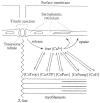Calcium indicators and calcium signalling in skeletal muscle fibres during excitation-contraction coupling
- PMID: 20599552
- PMCID: PMC2974769
- DOI: 10.1016/j.pbiomolbio.2010.06.001
Calcium indicators and calcium signalling in skeletal muscle fibres during excitation-contraction coupling
Abstract
During excitation-contraction coupling in skeletal muscle, calcium ions are released into the myoplasm by the sarcoplasmic reticulum (SR) in response to depolarization of the fibre's exterior membranes. Ca(2+) then diffuses to the thin filaments, where Ca(2+) binds to the Ca(2+) regulatory sites on troponin to activate muscle contraction. Quantitative studies of these events in intact muscle preparations have relied heavily on Ca(2+)-indicator dyes to measure the change in the spatially-averaged myoplasmic free Ca(2+) concentration (Δ[Ca(2+)]) that results from the release of SR Ca(2+). In normal fibres stimulated by an action potential, Δ[Ca(2+)] is large and brief, requiring that an accurate measurement of Δ[Ca(2+)] be made with a low-affinity rapidly-responding indicator. Some low-affinity Ca(2+) indicators monitor Δ[Ca(2+)] much more accurately than others, however, as reviewed here in measurements in frog twitch fibres with sixteen low-affinity indicators. This article also examines measurements and simulations of Δ[Ca(2+)] in mouse fast-twitch fibres. The simulations use a multi-compartment model of the sarcomere that takes into account Ca(2+)'s release from the SR, its diffusion and binding within the myoplasm, and its re-sequestration by the SR Ca(2+) pump. The simulations are quantitatively consistent with the measurements and appear to provide a satisfactory picture of the underlying Ca(2+) movements.
Copyright © 2010 Elsevier Ltd. All rights reserved.
Figures












Similar articles
-
A study of the mechanisms of excitation-contraction coupling in frog skeletal muscle based on measurements of [Ca2+] transients inside the sarcoplasmic reticulum.J Muscle Res Cell Motil. 2018 Apr;39(1-2):41-60. doi: 10.1007/s10974-018-9497-9. Epub 2018 Aug 24. J Muscle Res Cell Motil. 2018. PMID: 30143958 Review.
-
Comparison of myoplasmic calcium movements during excitation-contraction coupling in frog twitch and mouse fast-twitch muscle fibers.J Gen Physiol. 2013 May;141(5):567-83. doi: 10.1085/jgp.201310961. J Gen Physiol. 2013. PMID: 23630340 Free PMC article.
-
Measurement and simulation of myoplasmic calcium transients in mouse slow-twitch muscle fibres.J Physiol. 2012 Feb 1;590(3):575-94. doi: 10.1113/jphysiol.2011.220780. Epub 2011 Nov 28. J Physiol. 2012. PMID: 22124146 Free PMC article.
-
Simulation of Ca2+ movements within the sarcomere of fast-twitch mouse fibers stimulated by action potentials.J Gen Physiol. 2007 Sep;130(3):283-302. doi: 10.1085/jgp.200709827. J Gen Physiol. 2007. PMID: 17724162 Free PMC article.
-
Intracellular calcium movements during excitation-contraction coupling in mammalian slow-twitch and fast-twitch muscle fibers.J Gen Physiol. 2012 Apr;139(4):261-72. doi: 10.1085/jgp.201210773. J Gen Physiol. 2012. PMID: 22450485 Free PMC article. Review.
Cited by
-
Potentiation in mouse lumbrical muscle without myosin light chain phosphorylation: is resting calcium responsible?J Gen Physiol. 2013 Mar;141(3):297-308. doi: 10.1085/jgp.201210918. Epub 2013 Feb 11. J Gen Physiol. 2013. PMID: 23401574 Free PMC article.
-
Quantifying Ca2+ release and inactivation of Ca2+ release in fast- and slow-twitch muscles.J Physiol. 2012 Dec 1;590(23):6199-212. doi: 10.1113/jphysiol.2012.242073. Epub 2012 Oct 1. J Physiol. 2012. PMID: 23027818 Free PMC article.
-
Gene Ontology Groups and Signaling Pathways Regulating the Process of Avian Satellite Cell Differentiation.Genes (Basel). 2022 Jan 27;13(2):242. doi: 10.3390/genes13020242. Genes (Basel). 2022. PMID: 35205287 Free PMC article.
-
The multiple roles of phosphate in muscle fatigue.Front Physiol. 2012 Dec 11;3:463. doi: 10.3389/fphys.2012.00463. eCollection 2012. Front Physiol. 2012. PMID: 23248600 Free PMC article.
-
Comprehensive Simulation of Ca2+ Transients in the Continuum of Mouse Skeletal Muscle Fiber Types.Int J Mol Sci. 2021 Nov 17;22(22):12378. doi: 10.3390/ijms222212378. Int J Mol Sci. 2021. PMID: 34830262 Free PMC article.
References
-
- Baylor SM, Quinta-Ferreira ME, Hui CS. Isotropic components of antipyrylazo III signals from frog skeletal muscle fibers. In: Rubin RP, Weiss G, Putney JW Jr, editors. Calcium and Biological Systems. Plenum Publishing Corp; New York: 1985. pp. 339–349.
Publication types
MeSH terms
Substances
Grants and funding
LinkOut - more resources
Full Text Sources
Research Materials
Miscellaneous

